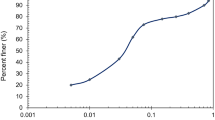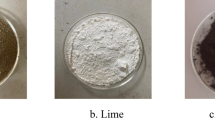Abstract
This paper presents the role of clay portion in soil used to stabilize soils during alkaline activation with potassium-based alkaline activator. A 10 M potassium hydroxide solution was utilized to activate the soils with and without palm oil fuel ash (POFA) at a solution. Soils with and without POFA mixtures were tested using unconfined compression tests and microstructural analysis (using scanning electron microscopy and X-ray diffraction). Comparing the strength of the mixtures with and without POFA, the results presented that short-term compressive strength was higher for mixtures with POFA. However, after longer curing the admixtures of higher kaolinite content with POFA reached significantly higher strength levels than the admixtures without POFA. This work brings new insights to the soil stabilization by alkaline activation providing a relatively new avenue for effective utilization of aluminosilicate source materials with parent-treated soils. The clay minerals of hosted soil play an important role in soil stabilization with alkaline activation that affects the behavior of binder with hosted soil.





Similar content being viewed by others
References
Pourakbar S, Asadi A, Huat BB, Fasihnikoutalab MH (2015) Stabilization of clayey soil using ultrafine palm oil fuel ash (POFA) and cement. Transp Geotech 3:24–35
Davidovits J (1988) Geopolymer chemistry and properties. In: Davidovits J, Orlinsl EJ (eds) Proceedings of 1st European conference on soft mineralurgy (Geopolymer ‘88). The Geopolymer Institute, Compiegne, France, pp 25–48
Davidovits J (1991) Geopolymers. J Therm Anal Calorim 37(8):1633–1656
Davidovits J (1994) Properties of geopolymer cements. In: Proceeding of first international conference on alkaline cements and concretes. Kiev, Ukraine, vol 1, pp 131–149
Duxson P, Provis JL, Lukey GC, Seth WM, Waltraud MK, Jannie SJVD (2005) Understanding the relationship between geopolymer composition, microstructure and mechanical properties. Colloids Surf A 269(1):47–58
Elkhebu A, Zainorabidin A, Bakar I, Huat BK, Abdeldjouad L, Dheyab W (2019) Alkaline activation of clayey soil using potassium hydroxide & fly ash. Int J Integr Eng 10(9):99–104
Pourakbar S, Asadi A, Huat BB, Fasihnikoutalab MH (2015) Soil stabilization with alkali-activated agro-waste. Environ Geotech 2(6):359–370
Fasihnikoutalab MH, Asadi A, Unluer C, Huat BK, Ball RJ, Pourakbar S (2017) Utilization of alkali-activated olivine in soil stabilization and the effect of carbonation on unconfined compressive strength and microstructure. J Mater Civ Eng 29(6):601–613
Alsafi S, Farzadnia N, Asadi A, Huat BK (2017) Collapsibility potential of gypseous soil stabilized with fly ash geopolymer; characterization and assessment. Constr Build Mater 137:390–409
Xu H, Van Deventer J (2000) The geopolymerisation of aluminosilicate minerals. Int J Miner Process 59(3):247–266
Cristelo N, Glendinning S, Fernandes L, Pinto AT (2013) Effects of alkaline-activated fly ash and Portland cement on soft soil stabilization. Acta Geotech 8(4):395–405
Cristelo N, Glendinning S, Miranda T, Oliveira D, Silva R (2012) Soil stabilization using alkaline activation of fly ash for self-compacting rammed earth construction. Constr Build Mater 36:727–735
Wallah S, Rangan BV (2006) Low-calcium fly ash-based geopolymer concrete: long-term properties. In: Res. Report-GC2. Curtin University, Perth, pp 76–80
Ariffin M, Bhutta M, Hussin M, Tahir MM, Aziah N (2013) Sulfuric acid resistance of blended ash geopolymer concrete. Constr Build Mater 43:80–86
Cristelo N, Glendinning S, Pinto AT (2011) Deep soft soil improvement by alkaline activation. Proc ICE Ground Improv 164(2):73–82
Habert G, d’Espinose de Lacaillerie JB, Roussel N (2011) An environmental evaluation of geopolymer based concrete production: reviewing current research trends. J Clean Prod 19(11):1229–1238
Sargent P, Hughes PN, Rouainia M, White ML (2013) The use of alkali-activated waste binders in enhancing the mechanical properties and durability of soft alluvial soils. Eng Geol 152:96–108
Zhang M, Guo H, El-Korchi T, Zhang G, Tao M (2013) Experimental feasibility study of geopolymer as the next-generation soil stabilizer. Constr Build Mater 47:1468–1478
Sperberga I, Spela P, Rundans M, Cimmers A (2015) Chemically and thermally activated illite clay from latvia. Mater Sci Appl Chem 32:27–32
Khale D, Chaudhary R (2007) Mechanism of geopolymerization and factors influencing its development: a review. J Mater Sci 42(3):729–746
Duxson P, Provis JL, Lukey GC, Van Deventer JS (2007) The role of inorganic polymer technology in the development of ‘green concrete’. Cem Concr Res 37(12):1590–1597
McLellan BC, Williams RP, Lay J, Van Riessen A, Corder GD (2011) Costs and carbon emissions for geopolymer pastes in comparison to ordinary Portland cement. J Clean Prod 19(9):1080–1090
Pourakbar S, Asadi A, Huat BB, Cristelo N, Fasihnikoutalab MH (2016) Application of alkali-activated agro-waste reinforced with wollastonite fibers in soil stabilization. J Mater Civ Eng 29:04016206
British Standards Institution (1990) Methods of test for soils and civil engineering purposes. BS1377, London
Tkaczewska E (2013) Mechanical properties of cement mortar containing fine-grained fraction of fly ashes. Open J Civ Eng 3(2A):54–68
Xin M, Zhang L, Ge S, Cheng X (2017) Effects of glass fiber modified with calcium silicate hydrate (C-S-H(I)) reinforced cement. IOP Conf Ser Mater Sci Eng 182:012040
Fasihnikoutalab M, Pourakbar S, Ball RJ, Huat BK (2017) The effect of olivine content and curing time on the strength of treated soil in presence of potassium hydroxide. Int J Geosynth Ground Eng. https://doi.org/10.1007/s40891-017-0089-3
Acknowledgements
The authors sincerely thank Universiti Putra Malaysia (UPM) for providing financial assistance and facilities for this research.
Author information
Authors and Affiliations
Corresponding author
Additional information
Publisher’s Note
Springer Nature remains neutral with regard to jurisdictional claims in published maps and institutional affiliations.
Rights and permissions
About this article
Cite this article
Abdeldjouad, L., Asadi, A., Nahazanan, H. et al. Effect of Clay Content on Soil Stabilization with Alkaline Activation. Int. J. of Geosynth. and Ground Eng. 5, 4 (2019). https://doi.org/10.1007/s40891-019-0157-y
Received:
Accepted:
Published:
DOI: https://doi.org/10.1007/s40891-019-0157-y




